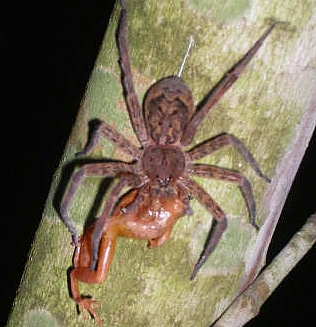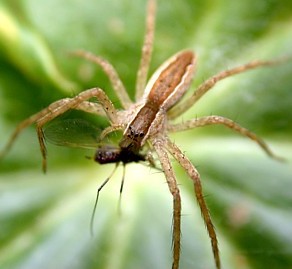|
|
ARTHROPODS:
Insects»
Spiders»
Centipedes»
Millipedes»
Sowbugs»
Harvestmen»
Mites
& Ticks»
Scorpions»
Identification
Tips»
About
the Critter Files»
Links» |
|
|
|
 |
NURSERY-WEB
& FISHING SPIDERS
Critter
Files/Spiders/Nursery-Web &
Fishing Spiders
By Blake Newton
University of Kentucky Department of Entomology |
| |
|
| Nursery-web and fishing
spiders are large, hairy spiders in the family Pisauridae. These
spiders are typically patterned with black, brown, white, and gray markings. Although
difficult to distinguish from wolf
spiders, nursery-web and fishing spiders are often slimmer
in build than commonly encountered wolf spiders. Like all spiders, nursery-web
and fishing spiders have 8 legs, 2 body parts, and fangs (called
"chelicerae"). Nursery-web and fishing spiders have
8 eyes. |
|
| SIZE:
Body length up to about 1" |
| |
| LIFE
CYCLE |
|
Simple
metamorphosis: like all spiders, young nursery-web and fishing spiders
hatch from eggs and look like tiny adults when they are born. They shed their
skin as they grow. After laying her eggs, a female nursery-web or fishing spider will wrap them into a silk eggsac. She will then carry
the eggsac in her chelicerae until the eggs hatch. When hatching
time arrives, the female will build a "nursery" in which
the eggs can hatch. The nursery often consists of a few leaves woven
together with silk. This forms a protective pocket into which
the eggsac is placed.
|
| ECOLOGY |
|
Many spiders in the
Pisauridae family are active hunters that search the ground for
insects, worms, spiders, and other small creatures. Others
are ambush predators that wait motionless for prey to come to them.
Fishing and nursery-web spiders are common in forests and
meadows, especially near streams and creeks, where they patrol rocks
and pebbles at the water's edge. Fishing spiders, in particular,
are very common around ponds and streams, and will even hunt for
prey on the water's surface, often by holding onto vegetation
at the water's edge. Pictured below is a fishing spider (Dolomedes genus) feeding on a small frog. This image was sent to us by Devin Cherry in Western Kentucky.
|
| |
 Fishing Spider preying on a frog (D. Cherry, 2008)
Fishing Spider preying on a frog (D. Cherry, 2008) |
| |
| PEST
STATUS |
|
People
who live close to wooded habitats may see nursery-web or fishing
spiders that wander into their homes from time to time. This
can be frightening, especially since the spiders are sometimes very
large. Although nursery-web and fishing spiders are big enough
to give a painful bite, they are not considered dangerous.
|
| |
| COMMON
KENTUCKY NURSERY-WEB & FISHING SPIDERS |
|
|
NURSERY-WEB
SPIDERS, Pisaurina spp.
GENUS: Pisaurina
Several species of Nursery-Web
Spiders live in Kentucky and all belong to the genus Pisaurina. Pictured below is Pisaurina mira. It is among the most commonly encountered nursery-web spiders in Kentucky. P. mira is about 1/2" long and often has a distinctive grey or brown stripe that runs along its cephalothorax and abdomen. Colors and patterns vary among individuals, however, and some specimens have a mottled pattern similar to the fishing spiders (pictured below).
|
| |
 Nursery Web Spider, Pisaurina mira (B. Newton, 2002)
Nursery Web Spider, Pisaurina mira (B. Newton, 2002) |
|
|
|
FISHING
SPIDERS, Dolomedes spp.
GENUS: Dolomedes
All Fishing Spiders
in Kentucky belong to the Dolomedes genus. Common Dolomedes
species in Kentucky are mottled with brown, gray, white, and black. One very large Kentucky fishing spider is Dolomedes tenebrosus (below left),
which has a legspan of up to about 3". It is commonly found on the
trunks of trees that are near water. The Six-Spotted Fishing
Spider (Dolomedes triton, below right), is slightly smaller
than D. tenebrosus, but it is nevertheless a very large
spider. It is often seen hunting on the water's surface in
ponds and slow-moving streams. Pictured below center is a male D. vittatus photographed at Tom Wallace Park in Louisville. Thanks to June Oakes for donating this image to us!
|
| |
 Fishing Spider, Dolomedes
tenebrosus
Fishing Spider, Dolomedes
tenebrosus
(R. Bessin, 2000) |
 Six-Spotted Fishing
Spider, D. triton
Six-Spotted Fishing
Spider, D. triton
(B. Newton, 2003) |
|
 Fishing Spider, Dolomedes
vittatus, male (J. Oakes, 2007)
Fishing Spider, Dolomedes
vittatus, male (J. Oakes, 2007) |
|
| |
| COLLECTING
& PHOTOGRAPHY |
|
Look for nursery-web
spiders and fishing spiders in wooded areas near streams and creeks.
Nursery-web spiders are often found in low vegetation in meadows near the forest edge. Fishing spiders are often found close to the ground, especially during
the day when they often hide under rocks and debris near stream beds. At
night, large fishing spiders can often be found on tree
trunks. If you don't disturb them, nursery web and fishing
spiders will often stay still for a picture. If you collect
one, remember: even though spiders in this family aren't very dangerous,
they can possibly bite. Also, all spiders should be preserved in alcohol.
|
| |
| NURSERY-WEB
& FISHING SPIDER FACTS |
|
Some fishing spiders
will partially submerge themselves underwater for brief periods of time to catch aquatic prey.
Although nursery-web
and fishing spiders resemble tarantulas, they are not closely related.
Nursery-web and fishing spiders are closely related to wolf
spiders.
Fishing spiders in other
parts of the world can grow very large! Read about this one from
South America: http://en.wikipedia.org/wiki/Ancylometes |
| |
| MYTHS
- LEGENDS - FOLKLORE |
|
Do you know any myths,
legends, or folklore about fishing spiders or nursery web spiders?
If so, let us know. |
Original document: 25 May 2004
Last updated: 1 Feb 2010
Photos courtesy R.
Bessin and B. Newton, University of Kentucky
The Kentucky Critter Files are maintained
by Blake Newton, Department of Entomology, University of Kentucky.
Contact: blaken@uky.edu |
|

